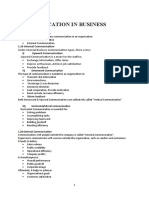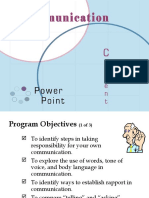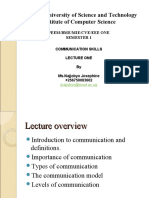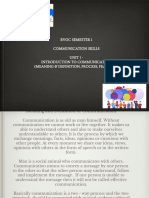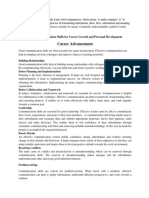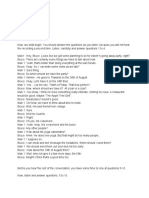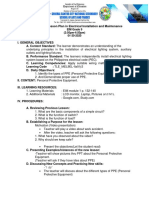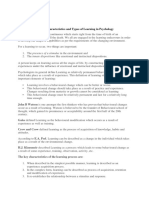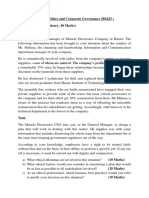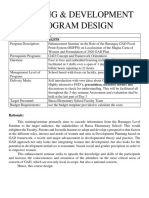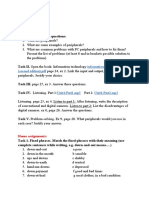Introduction to
Business Communication
Md. Awal Al Kabir
Assistant Professor
Jahangirnagar University
�What is communication
Transmission of a message from a sender to
a receiver in an understandable manner.
The communication is a guide toward realizing effective
communication.
Effective communication leads to understanding.
�WHAT IS COMMUNICATION
???
�Communication is the process by
which two or more people exchange
ideas ,facts, feelings, information
to reach to a mutual understanding
about a topic or problem of mutual
importance.
The term communication is
derived form the Latin word
COMMUNIS which means common
or community for good reason.
�Communication
is the transfer of information and
understanding from one person to another.It is the
way of reaching others with facts ,ideas, thoughts
and values .
Keith
Davis
Communication is any behaviour that results in
an exchange of meaning .
American Management
Association.
The process by which information is passed
between people by means of previously agreed
symbols in order to produce a desired response.
Peter Little
�The Importance of Communication
Skills as Expressed by Business
Authorities
Top executives from Fortune 500 companies
rate communications skills as the most
important quality for business leaders.
--Business Section
New York Times
There may be no single thing more important
in our efforts to achieve meaningful work and
fulfilling relationships than to learn and
practice the art of communication.
--Max De Pree, Author
The Art of Leadership
�Evidence of Communication
Weakness in Business
Im surprised how so many people
struggle with communication.
--Michael Rook, Production Manager
Hewlett Packard, San Diego, CA
The first thing the Human Resources
Department did was give me a writing
book.
--Sam Reeves, IT Consultant
AMS, Denver, CO
�Surveillance(Information) ,transmission of
cultural heritage , correlation of different parts of
society
(Herald Lasswell)
Entertainment (Wright,1960)
Interpret ,Connect and provide direction to an
interaction
Provide reward, relaxation and reduction of
tension.
Mobilize the opinion of people
Advance National Interests and promote certain
key values and behavioral patterns.
Help in reaching decisions
Safeguarding of civil liberties .
�Uses of effective
communication
Effective communication
helps to understand a person or
situation in a better way.
It enables us to solve the differences, build trust and
respect in the organization.
Sometimes our message is misunderstood or we
misunderstand the received message, effective
communication helps us to resolve problems with boths
point of view.
Effective communication helps us to connect well with kids,
spouse, boss, colleagues, etc.
It helps us in decision making.
��Origin of Communication can be traced back to the origin of
civilization
Non verbal communication signs,symbols, grunts
Verbal form of communication-Spoken form
Written communication Symbols, drawings
Print communication (1820)
�Electronic form of communication Radio(1930)
Television (1959)
Digitalization of Communication Tools(1995)
�7 Cs of Communication
�a. Completeness
The information conveyed in the message should be complete
for` the communication to be effective.
The sender must take into consideration the receivers mind
set and convey the message accordingly.
Complete communication enhances the reputation of the
organization.
Complete information always gives additional information
wherever required, it leaves no question in the minds of the
receiver.
Complete information helps in better decision making as it
serves all the desired and crucial information.
Complete information persuades the audience.
�b. Conciseness
Conciseness means communicating what you
want to convey in least possible words.
Conciseness is a necessity for effective
communication.
Concise communication provides short and
essential message in limited words.
Concise message is more appealing and
comprehensive to the audience.
Concise messages are non repetitive in nature.
�c. Consideration
Effective communication must take audience
into consideration by knowing the viewpoints,
back ground, mindset, educational level, etc.
Consideration implies stepping into the shoes
of others.
Consideration ensures that the self respect of
the audience is maintained and their emotions
are not harmed.
Consider the needs and requirements of the
audience to achieve effective communication.
�d. Clarity
Clarity implies emphasizing on a specific goal or
objective at a time, rather than trying to move
away from track.
Clarity helps to understand the message easily.
Complete clarity of thoughts and ideas enhances
the meaning of message.
Clarity comes with the use of exact, appropriate
and concrete words.
�e. Concreteness
Concrete communication implies being particular
and clear rather being fuzzy and general.
Concrete communication shows good level of
confidence.
Concrete information helps to strengthen the
reputation of the organization.
Concrete information cannot be misinterpreted.
�f. Courtesy
Courtesy means being polite, kind, judicious,
enthusiastic and convincing.
Courtesy is an important element of effective
communication.
Courtesy reflects the nature and character of the
sender of the message.
It is the same as give respect and then expect the
same.
Courtesy is not at all bias in nature.
�g. Correctness
Correctness in the communication implies that
the correct information is conveyed through
message.
Correct communication boosts up the confidence
level of the sender.
Correct information has greater impact on the
audience.
Free from grammatical errors and use of
appropriate and correct language.
Correct information includes the precision and
accurateness of facts and figures used in the
message.
�The communication
process
Communication is the process
of passing information from a
source to a receiver
�Communication
Models
Communication is classified into two
groups:
Linear
Interactive
�Linear Model
Here information is transmitted
from sender to receiver via a
channel without the sender
receiving any feedback (See fig
1)
�Linear Model
Example: Talking to a person
and that person is ignoring you
�Linear Model
Send
er
Messa
ge
Receiv
er
�Interactive Model
Here there is feedback; it
allows the sender to know that
the message was received.
�Interactive Model
Example:
Having
a
conversation with someone
�Interactive Model
Noise
Messag
e
Encoder
Sender
Decoder
Decoder
Receiver
Encoder
Feedba
ck
�Encoding
Encoding is putting thought or
information into words, signs or
symbols.
�Encoding
This allows the message to be
conveyed to the receiver.
�Message
Message is the information
being transmitted from the
sender to the receiver
�Channel
Is the medium used to
transmit the message
�Decoding
Is when the sender interprets the
message and gives it meaning
from his/ her perspective
�Feedback
Is the response given to the
sender from the receiver.
�Feedback
Allows the sender to determine if
the message was received and
how accurately it was received
�Noise
Anything that disrupts the
communication process for
example language.
�1.Sender
2.Encoding
3.Message
4.Media
5.Decoding
6.Receiver
7.Response
8.Feedback
9.Noise
�Barriers in Communication
Communicating is straightforward. What
makes it complex, difficult, and
frustrating are the barriers we put in the
way.
Top Barriers :
EXPECTATIONS
AVOIDANCE
FIXING
SCAPEGOATING
PROBING
SPEAKING IN CODE
CONTROL
BLAMING
CONFLICT AVOIDANCE
(CHAOS)
EXCLUSION
BOUNDARY OR BARRIER
Information overload
Trust and credibility
Time
Emotions
Message congruency
Objective : thoughts and goals
Subjective : feelings
��Over coming the barriers of
effective communication
Connecting with
The audience
Simple
Words
Summarizing
what has been said
Effective Questions
Seeking
Participation
Effective
Communication skills
Checking
for understanding
Body language
(Smile, Eye contact,
Gestures, tone)
Cultural
Sensitivity
�Path for good communication






































